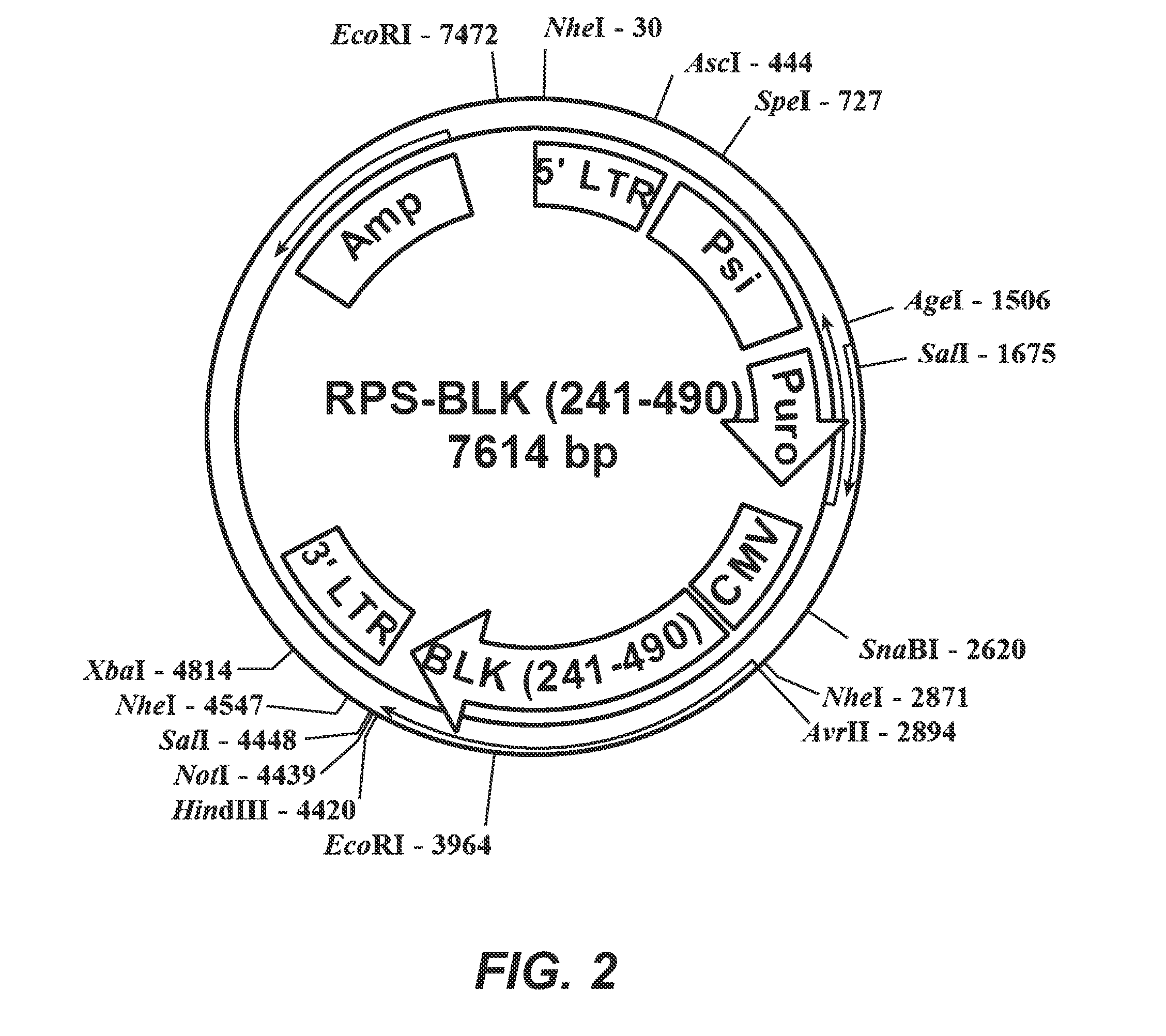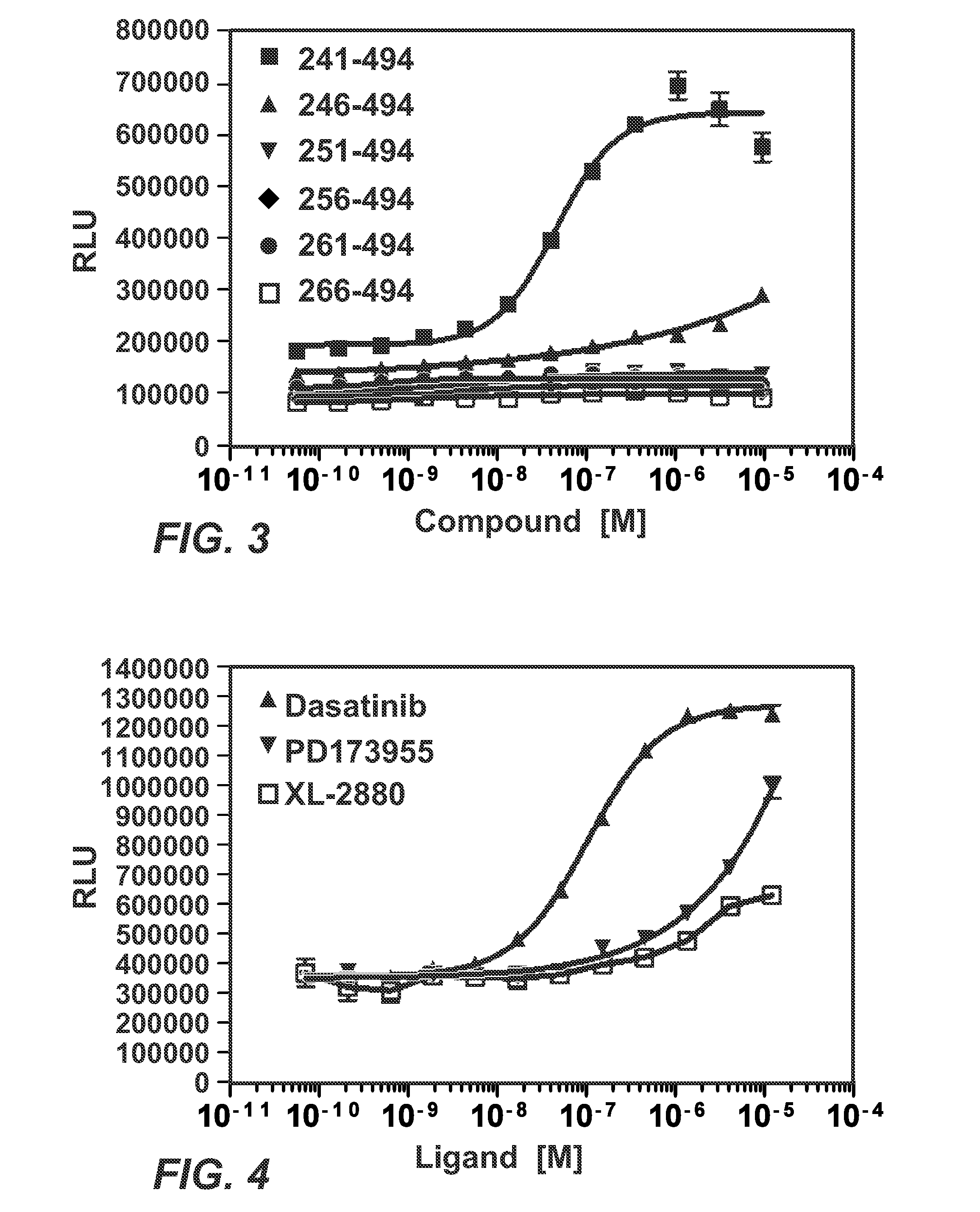Detection of intracellular binding events by measuring protein abundance
a technology of intracellular binding and abundance measurement, applied in the field of detection of intracellular binding events by measuring protein abundance, can solve the problems of preventing the use of certain extracellular proteins, time-consuming and expensive translocation assays, and intrinsic limitations of library-based methods such as protein probing and phage display
- Summary
- Abstract
- Description
- Claims
- Application Information
AI Technical Summary
Benefits of technology
Problems solved by technology
Method used
Image
Examples
example 1
Use of Binding Assay to Monitor Interaction Interfaces
[0149]Kinases bind ATP and catalyze the transfer of phosphate to target proteins. A general method of inhibiting kinase function is to apply a small molecule that blocks ATP binding to the target kinase. In this manner the compound is termed ATP-competitive.
[0150]To carry out the studies, fusions were made between the BLK and ProLabel.
[0151]The BLK (241-490)-PL amino acid sequence is shown below (SEQ ID NO. 7). The amino acid numbers 241-490 of the BLK (full length being 505 amino acids at GenBank Locus NP—001706) are shown within the sequence. The PL sequence is underlined, and the nucleotide binding sequence is bolded. The kinase domain is included in the sequence.
(SEQ ID NO. 7)M-(241)LRLVRKLGSGQFGEVWMGYYKNNMKVAIKTLKEGTMSPEAFLGEANVMKALQHERLVRLYAVVTKEPIYIVTEYMARGCLLDFLKTDEGSRLSLPRLIDMSAQIAEGMAYIERMNSIHRDLRAANILVSEALCCKIADFGLARIIDSEYTAQEGAKFPIKWTAPEAIHFGVFTIKADVWSFGVLLMEVVTYGRVPYPGMSNPEVIRNLERGYRMPRPDTCPPELYRGVIAECWRSRPEERPTFEFLQ...
example 2
Use of Binding Assay to Monitor Small Molecules as Inhibitors of Kinase Interactions
[0156]PDL173955 is a small molecule known to complex with the C-Abl kinase domain. Foretinib (GSK1363089, XL880) is a small molecule MET and VEGFR2 / KDR kinases inhibitor. Cells expressing the BLK-PL fusion were treated with the indicated ATP-competitive molecules for 6 hours. The cells were then lysed in the presence of EA and substrate; luminescence was measured 30 minutes later.
[0157]To carry out the binding assay to screen small molecules, fusions were made between the BLK and ProLabel, BLK-PL (SEQ ID NO. 7). The expression constructs were used to transduce HEK cells. The U2OS cell pools expressing the indicated BLK-PL fusion were shown to detect different affinity compounds (dasatinib, PD173955, XL-2880) by changes in efficacy and potency (FIG. 4).
example 3
Use of Binding Assay to Monitor Interaction of Fusion Protein with Known Compound and Inhibition by Small Molecules
[0158]B-cell lymphoma-2 (BCL2) and BCL-XL are anti-apoptotic proteins whose function is regulated by the binding of anti- or pro-apoptotic factors such as BAK (Bcl-2 homologous antagonist / killer).
[0159]As described in further detail in US 2008 / 0306127 entitled “Inhibiting the interaction of Bcl Proteins with binding partners,” the Bcl-2 family of proteins include both anti-apoptotic molecules, such as Bcl-2 and Bcl-XL, and pro-apoptotic molecules, such as Bax, Bak, Bid and Bad. Bcl-2 contributes to cancer cell progression by preventing normal cell turnover caused by physiological cell-death mechanisms. Members of the BCL1-2 family of proteins represent key regulators of apoptosis, with pro-apoptotic (e.g., Bax, Bak, Bid, Bim, Noxa, Puma) and anti-apoptotic function (e.g., Bcl-2, Bcl-xL, Mcl-1). Selective and competitive dimerization between pro- and anti-apoptotic membe...
PUM
| Property | Measurement | Unit |
|---|---|---|
| full-length | aaaaa | aaaaa |
| length | aaaaa | aaaaa |
| sequence lengths | aaaaa | aaaaa |
Abstract
Description
Claims
Application Information
 Login to View More
Login to View More - R&D Engineer
- R&D Manager
- IP Professional
- Industry Leading Data Capabilities
- Powerful AI technology
- Patent DNA Extraction
Browse by: Latest US Patents, China's latest patents, Technical Efficacy Thesaurus, Application Domain, Technology Topic, Popular Technical Reports.
© 2024 PatSnap. All rights reserved.Legal|Privacy policy|Modern Slavery Act Transparency Statement|Sitemap|About US| Contact US: help@patsnap.com










